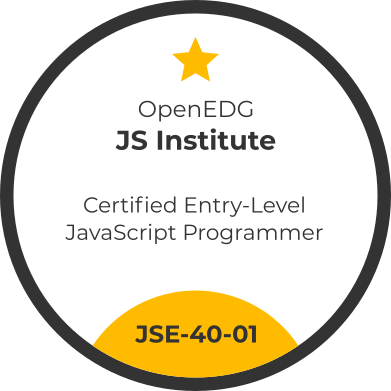- About
- Certifications
- Study Resources
-
Study Resources
- JavaScript Essentials 1
- JavaScript Essentials 2
- HTML Essentials
- CSS Essentials
General-Purpose Programming
Web Development
- Contact
- Voucher Store
Status: LIVE & ACTIVE

The exam consists of six sections:
Objectives covered by the block (3 exam items)
JSE-40-01 1.1 – Understand fundamental terms and definitions
JSE-40-01 1.2 – Set up the programming environment
JSE-40-01 – 1.3 Explain client-side execution of JavaScript code
Objectives covered by the block (6 exam items)
JSE-40-01 2.1 – Use variables effectively
JSE-40-01 2.2 – Define, identify, and use primitive data types in code: boolean, number, bigint, undefined, null
JSE-40-01 2.3 – Define, identify, and use primitive data types in code: string
JSE-40-01 2.4 – Perform type-casting operations
JSE-40-01 2.5 – Define, identify, and use complex data types in code: Object
JSE-40-01 2.6 – Define, identify, and use complex data types in code: Array
Objectives covered by the block (5 exam items)
JSE-40-01 3.1 – Recognize and proficiently utilize assignment, arithmetic, and string operators
JSE-40-01 3.2 – Identify and proficiently use logical and comparison operators
JSE-40-01 3.3 – Recognize and effectively use the ternary and other JavaScript operators
JSE-40-01 3.4 – Understand and implement operator precedence
JSE-40-01 3.5 – Implement the mechanism for interacting with the user
Objectives covered by the block (6 exam items)
JSE-40-01 4.1 – Implement the decision-making mechanism and organize the control flow with the if instruction
JSE-40-01 4.2 – Implement the decision-making mechanism and organize the control flow with the switch instruction
JSE-40-01 4.3 – Implement the decision-making mechanism and organize the control flow with the do-while and while loops, and the break and continue instructions
JSE-40-01 4.4 – Implement the decision-making mechanism and organize the control flow with the for statement
JSE-40-01 4.5 – Implement the decision-making mechanism and organize the control flow with the for-in statement
JSE-40-01 4.6 – Implement the decision-making mechanism and organize the control flow with the for-of statement
Objectives covered by the block (6 exam items)
JSE-40-01 5.1 – Organize and decompose the code using functions
JSE-40-01 5.2 – Organize and implement interactions between the function and its environment
JSE-40-01 5.3 – Apply function expressions and functions as first-class members in code
JSE-40-01 5.4 – Understand and implement the concept of recursion
JSE-40-01 5.5 – Explain and implement callback functions
JSE-40-01 5.6 – Explain and implement arrow functions
Objectives covered by the block (4 exam items)
JSE-40-01 6.1 – Classify and distinguish between different programming errors
JSE-40-01 6.2 – Compare and contrast different JavaScript errors and exceptions
JSE-40-01 6.3 – Understand, examine, and design an exception-handling mechanism in JavaScript
JSE-40-01 6.4 – Use different debugging and troubleshooting techniques